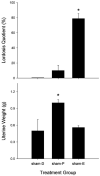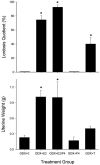Gonadal steroid hormone modulation of nociception, morphine antinociception and reproductive indices in male and female rats
- PMID: 12791435
- PMCID: PMC1420267
- DOI: 10.1016/s0304-3959(02)00457-8
Gonadal steroid hormone modulation of nociception, morphine antinociception and reproductive indices in male and female rats
Abstract
The purpose of this study was to examine how gonadal steroid hormones modulate basal nociception and morphine antinociception relative to regulating reproduction in the adult rat. Male and female Sprague-Dawley rats were either gonadectomized (GDX) or sham-gonadectomized (sham); GDX males were implanted subcutaneously with capsules containing testosterone (T), estradiol (E2), dihydrotestosterone (DHT), E2 and DHT, or nothing (0). GDX females received E2, T, or empty (0) capsules immediately after surgery, and vehicle or progesterone (P4) injections at 4-day intervals. Basal nociception and morphine antinociception were tested 28 days after surgery on 50 degrees C and 54 degrees C hotplate tests, and reproductive behavior and physiology were assessed shortly thereafter. There were no significant differences in baseline hotplate latencies among the male treatment groups, but morphine was significantly more potent in sham and GDX+T males than in GDX+0 males. The ability of T to increase morphine's potency was approximated by its major metabolites E2 and DHT, given together but not alone. Baseline hotplate latencies were higher in sham females tested during diestrus than in those tested during estrus. Morphine was significantly more potent in sham females tested during proestrus and diestrus than in those tested during estrus. Baseline hotplate latencies were significantly higher, and morphine was significantly less potent in GDX+E2, GDX+E2/P4 and GDX+T females than in GDX+0 females. All group differences in basal nociception and morphine antinociception observed on the 50 degrees C hotplate test were smaller and generally non-significant on the 54 degrees C hotplate test. Steroid manipulations produced the expected changes in reproductive behaviors and steroid-sensitive organs. These results demonstrate that in adult rats, gonadal steroid manipulations, that are physiologically relevant, modulate (1) basal nociception in females but not males, and (2) morphine's antinociceptive potency in both males and females.
Figures









Similar articles
-
Gonadal hormone modulation of mu, kappa, and delta opioid antinociception in male and female rats.J Pain. 2005 Apr;6(4):261-74. doi: 10.1016/j.jpain.2004.12.006. J Pain. 2005. PMID: 15820914 Free PMC article.
-
Dose- and time-dependent estradiol modulation of morphine antinociception in adult female rats.Eur J Pain. 2008 May;12(4):472-9. doi: 10.1016/j.ejpain.2007.07.014. Epub 2007 Sep 14. Eur J Pain. 2008. PMID: 17869144
-
Gonadal hormones do not alter the development of antinociceptive tolerance to delta-9-tetrahydrocannabinol in adult rats.Pharmacol Biochem Behav. 2015 Jun;133:111-21. doi: 10.1016/j.pbb.2015.03.021. Epub 2015 Apr 8. Pharmacol Biochem Behav. 2015. PMID: 25863271 Free PMC article.
-
Gonadal steroid modulation of neuroendocrine transduction: a transynaptic view.Cell Mol Neurobiol. 1996 Jun;16(3):357-82. doi: 10.1007/BF02088101. Cell Mol Neurobiol. 1996. PMID: 8818402 Free PMC article. Review.
-
Sex hormones and modulation of immunity against leishmaniasis.Neuroimmunomodulation. 2009;16(2):106-13. doi: 10.1159/000180265. Epub 2009 Feb 11. Neuroimmunomodulation. 2009. PMID: 19212130 Free PMC article. Review.
Cited by
-
Progesterone Attenuates Allodynia of Inflamed Temporomandibular Joint through Modulating Voltage-Gated Sodium Channel 1.7 in Trigeminal Ganglion.Pain Res Manag. 2020 Jul 25;2020:6582586. doi: 10.1155/2020/6582586. eCollection 2020. Pain Res Manag. 2020. PMID: 32774568 Free PMC article.
-
Sex-dependent influences of morphine and its metabolites on pain sensitivity in the rat.Physiol Behav. 2018 Apr 1;187:32-41. doi: 10.1016/j.physbeh.2017.11.030. Epub 2017 Dec 1. Physiol Behav. 2018. PMID: 29199028 Free PMC article.
-
Evaluation of menstrual cycle effects on morphine and pentazocine analgesia.Pain. 2011 Mar;152(3):614-622. doi: 10.1016/j.pain.2010.11.033. Epub 2011 Jan 15. Pain. 2011. PMID: 21239109 Free PMC article. Clinical Trial.
-
Evaluation of male infertility treatment following Rhus coriaria extract administration on rats exposed to morphine.Mol Biol Rep. 2020 Aug;47(8):6073-6081. doi: 10.1007/s11033-020-05682-2. Epub 2020 Jul 23. Mol Biol Rep. 2020. PMID: 32705505
-
PAG mu opioid receptor activation underlies sex differences in morphine antinociception.Behav Brain Res. 2007 Feb 12;177(1):126-33. doi: 10.1016/j.bbr.2006.10.028. Epub 2006 Nov 21. Behav Brain Res. 2007. PMID: 17118467 Free PMC article.
References
-
- Ali BH, Sharif SI, Elkadi A. Sex differences and the effect of gonadectomy on morphine-induced antinociception and dependence in rats and mice. Clin Exp Pharmacol Physiol. 1995;22:342–344. - PubMed
-
- Aloisi AM, Sacerdote P, Albonetti ME, Carli G. Sex-related effects on behaviour and -endorphin of different intensities of formalin pain in rats. Brain Res. 1995;699:242–249. - PubMed
-
- Alonso R, Lopez-Coviella I. Gonadal steroids and neuronal function. Neurochem Res. 1998;23(5):675–688. - PubMed
-
- Amandusson Å, Hallbeck M, Hallbeck A-L, Hermanson O, Blomqvist A. Estrogen-induced alterations of spinal cord enkephalin gene expression. Pain. 1999;83:243–248. - PubMed
-
- Baamonde AI, Hidalgo A, Andres-Trelles F. Sex-related differences in the effects of morphine and stress on visceral pain. Neuropharmacology. 1989;28(9):967–970. - PubMed

